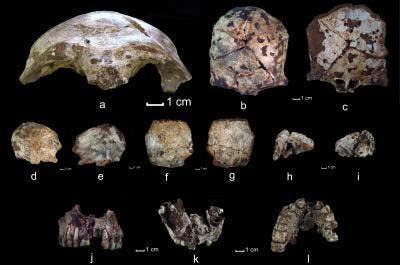Anthropologists have discovered an ancient skull in a cave in the Annamite Mountains in northern Laos, which according to subsequent dating is the oldest evidence of modern human presence found in Southeast Asia. This would clock on modern human migration through the region by as much as 20,000 years, and adds weight to the theory which states that our forefathers which left Africa didn’t just settle for the coastlines, but also inhabited diverse habitats much earlier than previously thought.
The team of researchers found the fragmented skull in the Annamite Mountains around the year 2009. This was the first bone dig in the country of Laos since the early 1900s. Back then, during the first digs at the turn of the last century, fossils were found which as old as 16,000 years. These latest findings however have been dated as being 46,000 to 63,000 years old.
“It’s a particularly old modern human fossil and it’s also a particularly old modern human for that region,” said University of Illinois anthropologist Laura Shackelford, who led the study with anthropologist Fabrice Demeter, of the National Museum of Natural History in Paris. “There are other modern human fossils in China or in Island Southeast Asia that may be around the same age but they either are not well dated or they do not show definitively modern human features. This skull is very well dated and shows very conclusive modern human features,” she said.
Of course, other bones or fragments have been found in Asia which have been either dated around time or much older, but modern human features haven’t been recognized.

(Photo Credit: Laura Shackelford)
No other fossils or artifacts were found alongside the skull, suggesting the excavated site wasn’t a dwelling place or burial site. Instead, it’s most likely that the body got washed up inside the cave, after the ancient human succumbed somewhere outside of it. This theory would go well with the age analyses, since uranium/thorium dating puts the skull at around 63,000 years old, while luminescence analyses date the surrounding soil to between 46,000 and 51,000 years ago. So, since the skull is much older than the soil in which it was found, the researchers believe that the body was indeed washed into the cave somehow, after which it was hidden and preserved in time by soil.
“Those dates are a bit younger than the direct date on the fossil, which we would expect because we don’t know how long the body sat outside the cave before it washed in,” says Shackelford.
“This fossil find indicates that the migration out of Africa and into East and Southeast Asia occurred at a relatively rapid rate, and that, once there, modern humans weren’t limited to environments that they had previously experienced. We now have the fossil evidence to prove that they were there long before we thought they were there.”
The discovery also bolsters genetic studies that indicate that modern humans occupied that part of the world at least 60,000 years ago, she said.
“This is the first fossil evidence that supports the genetic data,” she said.
The findings were presented in the journal Proceedings of the National Academy of Sciences.






